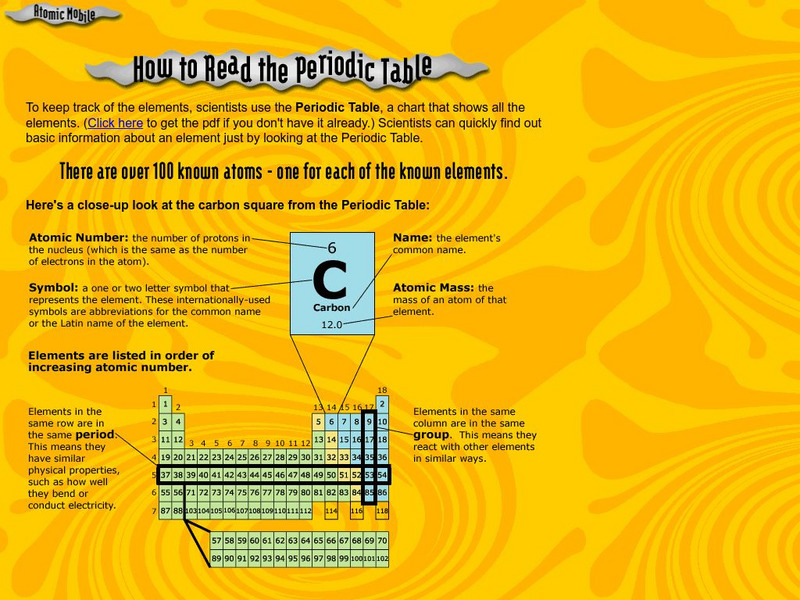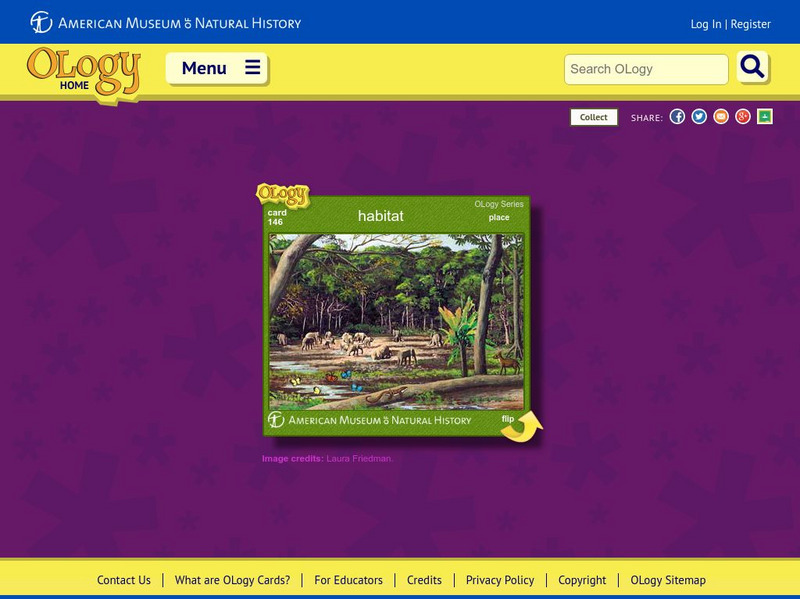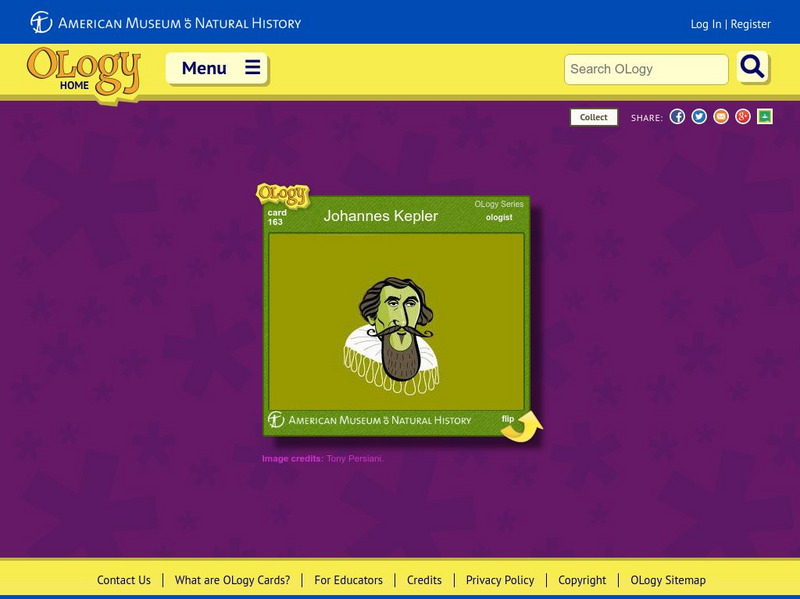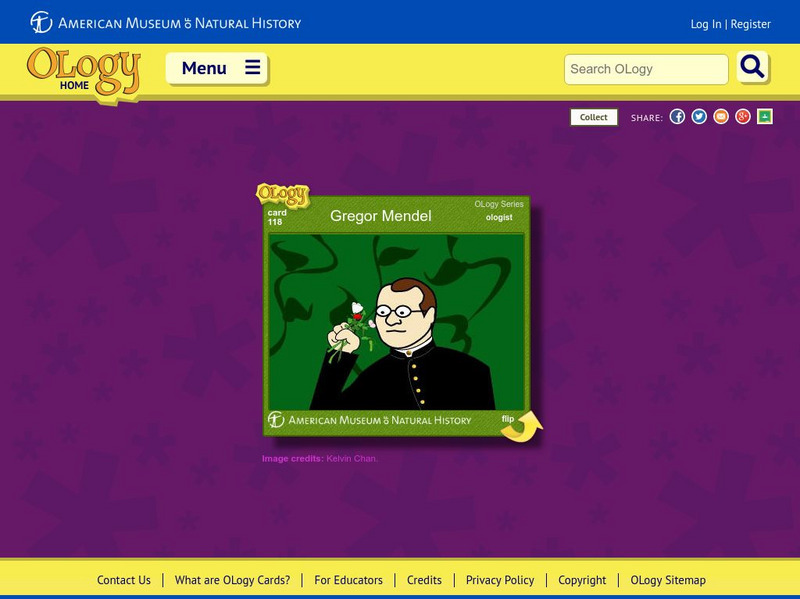American Museum of Natural History
American Museum of Natural History: Ology: Brain: Boost Your Brain Power!
Test how good and how quick your visual memory is in these games of recall.
American Museum of Natural History
American Museum of Natural History: Ology: Kinds of Biodiversity
Explains what biodiversity is, why it is important, threats it faces, and what people can do to help it survive.
American Museum of Natural History
American Museum of Natural History: Ology: Life in the City
Explore a city park to learn what tiny species live there.
American Museum of Natural History
American Museum of Natural History: Resources: Time Dilation Equation
Using an example of light bouncing back and forth between two mirrors in a rocket, time dilation is explained in this resource. Step-by-step calculations using Einstein's time dilation equation are shown.
American Museum of Natural History
American Museum of Natural History: O Logy: Stuff to Do: Stargazing
Get started on the road to becoming an expert stargazer by following these recommendations for identifying stars, planets, and constellations. Includes an example of a journal that can be used as a record of your investigations.
American Museum of Natural History
American Museum of Natural History: O Logy: Stuff to Do: Make a Weather Station
Make a wind vane, rain gauge, and barometer and learn how to measure wind direction, rainfall, and air pressure.
American Museum of Natural History
American Museum of Natural History: O Logy: Stuff to Do: Atomic Mobile
Illustrated instructions for how to make a model of an atom (an atom mobile).
American Museum of Natural History
American Museum of Natural History: O Logy: How to Read the Periodic Table
An illustrated how-to for understanding how to read and extract information from the periodic table.
American Museum of Natural History
American Museum of Natural History: O Logy: What's the Big Idea? Paleontology
Snapshot reference on paleontology explains how the fossil record drives this area of science.
American Museum of Natural History
American Museum of Natural History: Resources for Learning: The Path to El Nino
Through this resource, students explore the history, causes, effects, and patterns of El Nino.
American Museum of Natural History
American Museum of Natural History: Resources for Learning: Bolivia Biodiversity
An overview, in a captioned gallery of images, of the plant and animal life of Bolivia as well as some of the cultural traditions and practices among Bolivian people.
American Museum of Natural History
American Museum of Natural History: Ole Roemer and the Speed of Light
This resource provides a concise overview of the speed of light and the Ole Roemer, the first man to measure it.
American Museum of Natural History
American Museum of Natural History: Profile: Georges Lemaitre
Find out about the life and work of the father of the Big Bang theory, Georges Lemaitre. This article describes the origin of the cosmology theory and its growing acceptance among scientists. This is an excerpt from COSMIC HORIZONS:...
American Museum of Natural History
American Museum of Natural History: Dinosaurs: Theropod Biomechanics
How fast could a Tyrannosaurus rex really run? Visitors to this resource will see how scientists use theropod biomechanics to simulate the movement of these large dinosaurs.
American Museum of Natural History
American Museum of Natural History: Dinosaurs: Ancient Fossils, New Discoveries
Visitors to this resource will discover the new things that scientists are learning about dinosaurs by paging through the information about this comprehensive exhibition.
American Museum of Natural History
American Museum of Natural History: Exhibition: Extreme Mammals
Learn about the body structure, habitat, reproduction, movement, and evolution of extreme mammals, both extinct and living, through interative animation and short videos.
American Museum of Natural History
American Museum of Natural History: Ology: In Pictures: Journey to the Stars
Two astrophysicists present images of stellar phenomena in this resource and explain why stars are so important to the existence of life on Earth.
American Museum of Natural History
American Museum of Natural History: O Logy: Bio Benefits
What does it take to keep our planet livable? What are the things we need to sustain life? The Bio-Benefits site answers these questions and others pertaining to basic life needs. Click on the hyperlinked words to see interactive...
American Museum of Natural History
American Museum of Natural History: O Logy: Stuff to Do: Buried Bones
A how-to science project with instructions to make a complete dinosaur bone dig site burying chicken bones in plaster of Paris. Click on the starred words to learn more about the topic.
American Museum of Natural History
American Museum of Natural History: Ology: Saving Species
Click on the country name to travel to the Bahamas, Madagascar, and Australia to see what scientists are learning about different species, what roles they play in their ecosystems, and how we can best protect them. Click on the starred...
American Museum of Natural History
American Museum of Natural History: Habitat O Logy Card
Flip this interactive OLogy card to find fast facts, questions and answers, and other bite-size pieces of information about the meaning of habitat, as a scientific concept, and learn why habitat is so important to plants and animals.
American Museum of Natural History
American Museum of Natural History: Johannes Kepler O Logy Card
Flip this interactive OLogy card to find fast facts, questions and answers, and other bite-size pieces of information about Johannes Kepler.
American Museum of Natural History
American Museum of Natural History: Gregor Mendel O Logy Card
Flip over this interactive OLogy card and start learning bite-size pieces of useful information about Gregor Johann Mendel.
American Museum of Natural History
American Museum of Natural History: Giant Squid O Logy Card
Flip over this interactive OLogy card and start learning bite-size pieces of useful information about the giant squid, including details regarding its 2006 discovery.


















